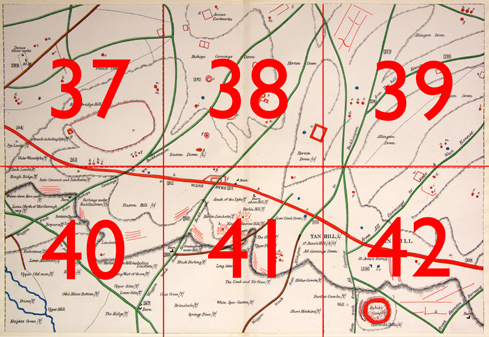AC Smith Maps: Map G. Squares 37 to 42
Tan Hill, Rybury Camp
Square 37:
a. "We meet again with a portion of Wansdyke".
b. Very low barrow. Hoare opened it in 1814, finding a cist with skeleton. Close to the head was a drinking cup.
c. Small low bowl-shaped barrow, with ditch. Opened at top.
d. The very smallest of barrows.
e. Very low barrow, opened at top.
f. Very low barrow. Opened at top by Thurnam, who found a female skeleton in a shallow cist, and a few teeth of the ox. Described in WAM Vol. vi, p. 323 No. 6.
g. A pit, probably a dew pond.
h. Bowl-shaped barrow without ditch; opened at top by Cunnington, who found cremated bones.
i. Very low barrow. Opened by Thurnam, who found the burnt bones of a female or young person. Described in WAM Vol. vi, p. 323 No. 7.
j. Very low barrow. Opened by Cunnington, who found burnt bones.
k. Another very low barrow opened by Cunnington. Finds as h.
l. Very low barrow - as k.
m. A low barrow, easily passed over.
n. Another low barrow.
o. Wide but low bowl-shaped barrow, no ditch. Opened by Thurnam, who found burnt bones, fragments of pottery and two ivory pins, one tinged with bronze.
p. Very wide and low bowl-shaped barrow. Thurnam found only burnt bones.
q. Very wide and low barrow. Thurnam found burnt bones, an incense cup and an ivory bead, with animal bones.
r. A small low barrow, opened at top.
s. Ditch and bank.
t. u. "Here I had marked two barrows, now gone."
v. A bank and ditch; seems to denote an ancient enclosure.
Square 38:
a. Large, square enclosure, surrounded by a ditch with a high bank inside.
b. Cluster of square, circular and oblong enclosures. One large sarsen in the most northern circle.
c. Another large enclosure with bank and ditch.
d. Small square enclosure.
e. Bowl-shaped barrow, opened at top.
f. Bell-shaped barrow with deep ditch. Thurnam found burnt bones and a grooved pin. Reported in WAM, Vol. vi, p. 323 No. 12
g. Long barrow, much mutilated, opened at top. Thurnam found 4 skeletons. (ref above, No. 13)
h. Irregular earthworks.
i. Low bowl-shaped barrow with slight ditch. Thurnam found burnt bones and black pottery. (ref above, No. 11)
k. Irregular enclosure.
l. Banks of another enclosure.
m. Very low barrow, opened at top.
n. Small low barrow. Thurnam found burnt bones (ref above, No. 14)
Square 39:
a. Very flat low barrow, almost obliterated.
b. Very tall bowl-shaped barrow without ditch; opened at top.
c. Bowl-shaped barrow without ditch; large hole at top where opened.
d. Bowl-shaped somewhat flat barrow, no ditch. Opened at top.
e. Very large disc-shaped barrow with very small tumulus in centre.
f. Very wide disc-shaped barrow.
g. Disc-shaped barrow.
h. Disc-shaped barrow, very large and wide, with a tump in the middle.
i. Enclosure surrounded by bank and ditch; indistinct.
k. Another indistinct enclosure.
l. Small low barrow.
m. Site of a bowl-shaped barrow; disappeared in about 1878.
n. Bowl-shaped barrow opened at top. Very much mutilated.
Square 40:
a. Wansdyke. Smith reports that in 1817 the earthwork was cut through, revealing two stages of construction.
b. Small bowl-shaped barrow, no ditch.
c. Bowl-shaped barrow, no ditch.
d. very small, low, bowl-shaped barrow, no ditch.
Square 41:
a. Bowl-shaped barrow with ditch. Thurnam found burnt bones of a female or young person, a bead of bluish glass and three larger ones with a pendant, all of jet. (WAM, Vol. vi, p. 324 No. 15)
b. Large bowl-shaped barrow. Thurnam reported a found "circular chipped disc of flint". (ref as above)
c. Large bowl-shaped barrow with ditch. Opened by Thurnam, who found a red clay urn filled with burnt bones. (ref as above, No. 16)
d. Large semicircular ditch.
e. Low bowl-shaped barrow with ditch.
f. Earthwork.
g. Very low but wide bowl-shaped barrow, no signs of opening.
h. Very large mound, surround by broken ground and many pits, as if of hut circles. Possibly a mutilated long barrow.
i. Another mound like h. Smith thinks it military, though shepherds call it a barrow.
k. Wansdyke traverses this square.
Square 42:
a. Wansdyke. Nearby are two barns, where Tanhill Fair is held every 6th of August.
b. Rybury Camp.
c. Bowl-shaped barrow, opened at top. Probably the one opened by Thurnam, who described bones and teeth of sheep and oxen; pieces of deer horn and a fragment of black pottery. Below this were 2 circular cists filled with grey ashes and bones. (ref as above, No. 17)
d. Square enclosure with bank and ditch.
e. Large bowl-shaped barrow, opened at top.
f. Two small low twin barrows, opened at the side.
g. Very low bowl-shaped barrow, almost invisible.
h. Very low barrow, opened at top.
i. Possible barrow.
k. Banks and ditches.
l. A most indistinct barrow.
m. Banks and ditches - perhaps a covered way?











